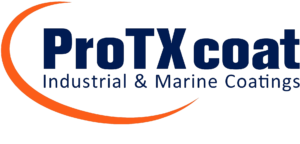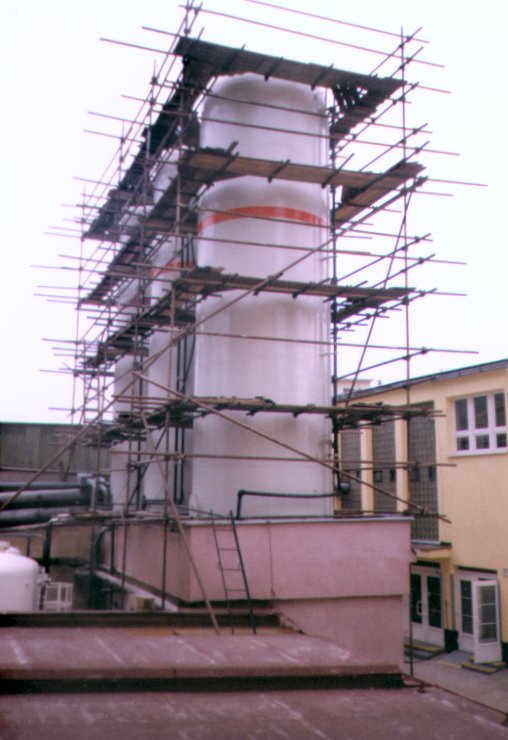ProTXcoat 312CRHT
Ultra Chemical Resistant Novolac High Temp
High Temperature Chemical Resistant Epoxy Novolac
312CRHT is a high performance solvent free epoxy novolac coating designed for use where exceptional resistance to chemical attack is required at elevated immersion temperatures.
312CRHT is based on a special epoxy novolac resin and a polyamine curing agent system which produces a highly cross linked polymer network. This unique system prevents permeation and subsequent attack of the coating by highly aggressive chemicals, allowing the system to be used whenever superior chemical resistance is required.
312CRHT offers excellent adhesion to steel and concrete, has outstanding resistance to a wide range of industrial chemicals even under total immersion conditions and is ideal for tanks, pipework, containment dykes, bund areas, desulphurization units.
Before proceeding, please read the following information carefully to ensure that the correct application procedure is fully understood.
TECHNICAL SPECIFICATIONS
Surface preparation
Steel Surfaces – Surfaces should then be abrasive blast cleaned to a minimum Sa21⁄2 – Sa3 BS7079 Part A1 : 1989 or equivalent with a blast profile of 75 – 125 microns corresponding to ‘Rough’ in ISO 8503/1. All loose abrasive dust and debris must be blown clear or vacuum cleaned away.
Steel surfaces do not require priming but should be coated within 4 hours of blast cleaning to prevent rash rusting.
Concrete Surfaces – All concrete to be coated should either be lightly abrasive blast cleaned using wet or dry abrasive techniques or alternatively high pressure water jetting. Care must be taken not to expose the aggregate in the concrete. All dust and abrasive material shall be removed from the surface prior to coating.
Mixing
312CRHT is a two component material comprising base and activator components which must be mixed together prior to use. Material is best spray applied with heated plural component spray equipment for larger surfaces
Stir the contents of the base component, continue stirring and gradually add the total contents of the activator container, stir the combined mix until completely homogenous.
The mixed materials should be used within 25-30 minutes of mixing at 20°C (68°F). This time will be reduced at higher temperatures and extended at lower temperatures.
Applicaiton
For spray application, in order to achieve atomization when spraying, heat should be applied to both Base and Activator components as follows: Base: 50-60°C Activator : 35-40°C Trace heating on lines should be maintained at 45-50°C
Dependent on the pump ratio, adjust the compressed air pressure to give a tip pressure of 4200psi / 290Bar at the tip. Spray using a 21-23 thou / 0.50 – 0.75mm tip.
Spray apply the material in sufficient passes to achieve a minimum thickness of 500 microns checking the film thickness regularly with a wet film thickness gauge and brushing out the test marks. As a guide, 1litre of material should be sufficient to cover 1.6 sq meters allowing for wastage.
312CRHT Application should not be carried out at temperatures below 5°C nor when relative humidity exceeds 85% or when the surface to be coated is less than 3°C below the dew point.
Best application results are obtained at a minimum substrate and product temperature of 20oC. For optimum chemical resistance, the system must be applied and cured at a minimum temperature of 20oC for at least 7 days prior to return to service.
312CRHT is also suitable for application by brush or roller, using good quality brushes or short to medium pile rollers.
0nce the coating has cured, carry out a full visual inspection to confirm freedom from pinholes and misses and as a further aid to confirm continuity of the coating if on steel , carry out inspection by wet sponge test using detergent as a wetting agent. Where the need for remedial work on isolated defects is found necessary, the surface should be abraded or lightly flash blasted prior to cleaning, masking off within the prepared area and coated by brush at approximately 250 microns thickness
Coverage Rate
1.75sqm per kg at 400 microns
Detailed working recommendations are available from the Technical Centre on request.
Physical constants
| Mixing Ratio | Base | Activator |
| 4 | 1 By volume | |
| Appearance | Base | Colored liquid |
| Activator | Amber fluid | |
| Drying & Cure Times at 20°C (68°F) | Usable Life | 25 minutes |
| Initial Set | 6 hours | |
| Min Overcoat | 6 hours | |
| Max Overcoat | 8 hours | |
| Light Load | 12 hours | |
| Full Load/immersion | 4 days | |
| Full Chemical | 7 days | |
| Post Cure | 312CRHT has been formulated to optimize resistance to mineral acids up to 90°C immersion temperature. In addition, after an initial curing period of at least 12 hours at 20°C, raising the cure temperature progressively to 60 – 80°C for up to 8 hours will result in improved mechanical, thermal and chemical resistance properties |
Physical properties
Abrasion Resistance 60 mgm loss per 1000 cycles ASTM D 4060 -1 kg load-CS17 wheel
Dry Heat Resistance 240oC ASTM D2485
Water Vapor Permeability 4.69 x 10-6 perm.cm ASTM D1653
Salt Fog Resistance Excellent, unaffected after ASTMB117 10,000hrs exposure
Humidity Resistance 5,000hrs exposure BS 3900 Part F2
Health and safety
As long as normal good practice is observed 312CRHT can be safely used.
Protective gloves should be worn during use.
A fully detailed Safety Data Sheet is either included with the material or is available on request.
Packaging
Supplied in 20kg packs
The information provided in this Product Data Sheet is intended as a general guide only and should not be used for specification purposes. The information is given in good faith but we assume no responsibility for the use made of the product or this information because this is outside the control of the company. Users should determine the suitability of the product for their own particular purposes by their own tests.



